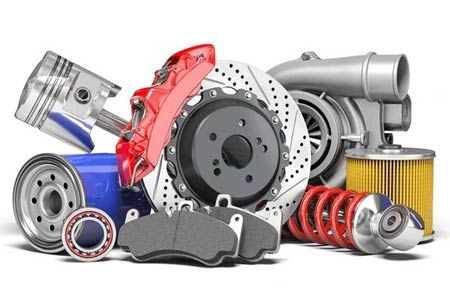- +91-8624883983
- info@insightsmicro.com
Automotive Parts : Global Trends, Facts and Figures

The vehicle parts market share is one of the most important activities in the automotive trade, which involves creating, marketing, and marketing the necessary vehicle parts. The business also consists of the availability of original equipment manufacturer (OEM) parts as well as aftermarket parts, all of which are used to make cars last longer, easier to drive, and even safer on the road. The increasing use and development of electric vehicles, connected vehicles, and environmentally friendly practices mean that the automotive industry is changing fast.
In 2024, the global automobile part market size was estimated at around 1.9 trillion U.S. dollars and is anticipated to grow by 5.2% between 2024 and 2030. The global automotive parts industry will rise with the growth in the number of vehicles produced, the increase in the demand for replacement parts in cars, the evolution of technology, and also the increasing expansion in the aftermarket segment. Western Europe, Asia-Pacific, North America, and Latin America constitute the leading regions responsible for this growth.
Global Automotive Parts Industry
Overview
The vehicle parts market share is one of the most important activities in the automotive trade, which involves creating, marketing, and marketing the necessary vehicle parts. The business also consists of the availability of original equipment manufacturer (OEM) parts as well as aftermarket parts, all of which are used to make cars last longer, easier to drive, and even safer on the road. The increasing use and development of electric vehicles, connected vehicles, and environmentally friendly practices mean that the automotive industry is changing fast.
In 2024, the global automobile part market size was estimated at around 1.9 trillion U.S. dollars and is anticipated to grow by 5.2% between 2024 and 2030. The global automotive parts industry will rise with the growth in the number of vehicles produced, the increase in the demand for replacement parts in cars, the evolution of technology, and also the increasing expansion in the aftermarket segment. Western Europe, Asia-Pacific, North America, and Latin America constitute the leading regions responsible for this growth.

Types & Definition
The automotive parts industry is the manufacture and marketing of all the components and support equipment needed for the functioning of a motor vehicle. These industries can cater to new vehicle production in view of OEM parts or maintenance and repairs of vehicles in a pre-existing condition, especially through the use of aftermarket parts.
1. The engine's functional parts include crankshafts, pistons, camshafts, and driving gears such as injectors.
2. The transmission/powertrain parts include transmission cases, gears, and discs with splines.
3. Electronics/Electrical Parts- Mainly relates to batteries, alternators, infotainment devices, and various sensors.
4. The brake and suspension components include brake rotors, pads, shocks, wheel bearings, and ball joints, among others.
5. Scythes' interior parts include the cushion, dashboards, bumpers, and lights.
6. The wheel and tire components include performance tires, aluminum rims, and brake systems.
Industry Trends
1. Introduction and Spread of Hybrid Accessories with More Advanced Electric Supporting Components – The demand for electric batteries and powertrains in electric vehicles is growing rapidly.
2. Development of Southeast Asian Economies and Car Maintenance, Including Aftermarket Parts—Due to Greater Spending by Their Consumers.
3. Development of intelligent and always-on components- Growth of smart car parts powered by the internet of things and artificial intelligence benefits inches.
4. Environmentally conscious manufacturing of the parts involves the use of materials that have minimal impact on the environment.
5. Design and Fabrication of Parts using a 3D printer- Such innovation is useful for mass customization.
Facts & Insights
Rise of Electric Vehicle Components: According to some estimates, such as the Automotive Pipe Manufacturers Association (APMA), electric car parts will see a 15 percent CAGR by 2030.
The development of the aftermarket: Since this automotive case study class involves the replacement of components, the automotive after-sales market is forecasted to attain $500 billion in the year 2028.
Increased focus on sustainability: The amount of waste greatly diminishes the carbon footprint, and this is done by increasing the percentage of reusable and recycled material.
Aiding Technology: Increasing the number of smart components in vehicles, including artificial intelligence-assisted troubleshooting.
Crash Avoidance Development: Increasing inclusion of autonomous and protective features.
Market Segment
Structure according to components:
1. Engine
2. Transmission
3. Electricity
4. Suspension
5. body panels.
By Usage:
1. Cars (four-wheelers)
2. Heavy commercial vehicles
3. Electric vehicles.
By geographical distribution:
1. North America
2. Europe
3. Asia-Pacific
4. Latin America
5. the Middle East
6. Africa.
Industry Leader
1. Bosch- A leading firm providing full integration of mechanical and electronic components.
2. Continental AG- One of the leaders in producing advanced brake and electronic systems.
3. Denso- It is expecting to supply robust heat systems and automotive systems in the near future.
4. ZF Friedrichshafen AG- the company focuses mainly on the development of modern transmission systems and chassis elements.
5. Magna- It deals with bodywork offenders such as seating and power units.
6. Valeo- In particular, its heat, drive, and ADAS solutions.
7. Bridgestone and Michelin- These are innovative tire producers who respect ecological principles.